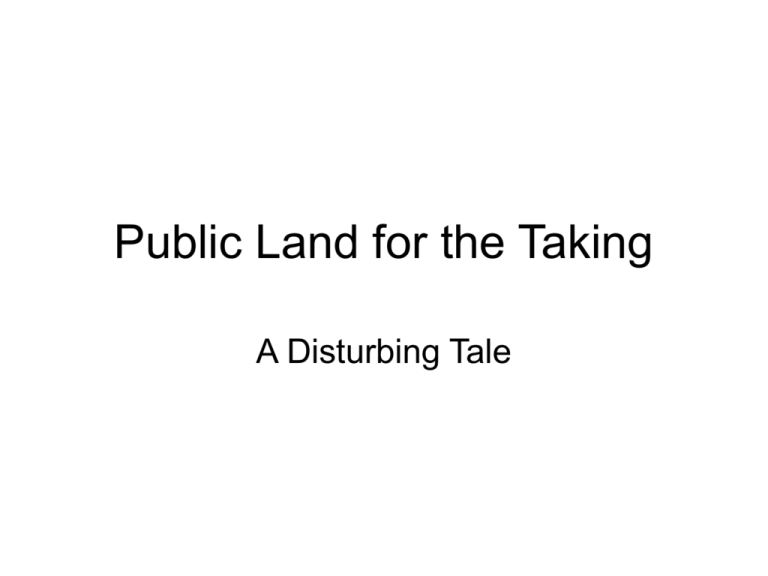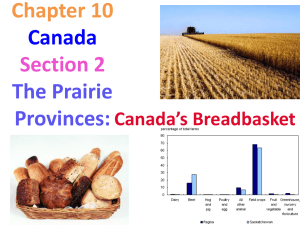Cheryl Bradley
advertisement

Public Land for the Taking A Disturbing Tale Outline • • • • • What is native prairie and what remains? Of what value native prairie? Stewardship of native prairie on public land Sale of public land: law, policy and practice. A disturbing tale about the plan to turn prairie on public land into potato fields • Hope? Prairie is defined by deep rooted grasses and other drought-resistant vegetation. Shrubs and trees grow in moister areas. Wetlands dot the landscape. In the parkland, grasslands intermingle with aspen woodlands. 70 – 80% of what was native prairie is now cultivated fields and settlement Landscape Fragmentation of Remaining Prairie Native Prairie and Parkland Remaining • 20-30% of native prairie remains (about 5% of Alberta) • About two-thirds of native prairie is on public land • <1% protected Public Private Environmentally Significant Areas •Large blocks of native prairie are few. •ESAs are areas of native prairie that are assessed as highly important to the longterm maintenance of biological diversity, soil, water, or other natural processes. They contain rare or unique species and features that may require special management for their conservation. Native prairie constitutes about 5% of the provincial land base, and yet supports: • 50% of the rare ecological communities (grassland, shrubland and wetland), • 40% of rare vascular plant species • 70% of wildlife species considered “at risk” or “may be at risk” Source: Alberta Conservation Information Management System Ecological Goods and Services – Alberta Native Prairie • • • • • • • • Biodiversity maintenance Critical habitat for wildlife Watershed/Soil protection Carbon storage Sustainable rangeland ecosystem Recreation Open space and aesthetics Land surface for mineral extraction Economic opportunity is accommodated on public lands by issuing dispositions not leading to ownership. Oil & Gas Leases Grazing Leases Stewardship of public rangelands is accomplished by applying measures of ecological health Healthy with problems Healthy Unhealthy Sale of public land in southern Alberta is driven by an ideology that native prairie is wasteland that can be “improved” by cultivation and settlement. Public Land Sales 1996/97 – 2009/10 Total sold in 14 years is 102,395 acres (160 mi2) Average sold is 7,313 acres/year 14,000 12,000 10,000 8,000 Area (acres) 6,000 4,000 2,000 0 96/97 99/00 02/03 05/06 08/09 Note: Stats do not include tax recovery transactions Process for Sale of Public Land 1. Application submitted by a party that holds a disposition on the lands or has the consent of the disposition holder 2. Government determines whether the public lands are suitable for sale (through internal referrals) considering – impact on resource values and environment – conform with land use policies – availability of private land for uses of economic or social importance 3. If the land is suitable for sale, it is sold by public auction or tender. The current disposition holder does not have a priority right. Bow Island Land Sale A Disturbing Tale Application made for sale of 25 sections (16,000 acres) of public land, more than sold in any year in the past 14 years Applicant (SLM Spud Farms) only recently acquired the grazing lease on some of the lands to be sold through a land swap. Applicant did not have the consent of the disposition holder on most of the lands considered for sale. Bow Island Land Sale A Disturbing Tale Confusion about Tax Recovery status. Bow River Irrigation District agreed to provide large volumes of irrigation water for the project using water saved through efficiency improvements. The degrading lower Bow River would not benefit. Suitability of the lands for irrigation was not assessed. Private lands are available for potato production Bow Island Land Sale A Disturbing Tale Determination of whether the public lands are suitable for sale was not made prior to the sale being brought to the Minister for decision; or if it was, it was ignored. Lands are part of a Environmentally Significant Area (national significance). There are at least four species legally listed at risk federally and provincially known to occur in the area. Others are expected to occur but inadequate survey. Bow Island Land Sale A Disturbing Tale Misrepresentation of conservation land trusts (e.g. NCC) by the Minister Intent was to sell the land directly to the applicant without public auction or tender. Lack of openness, transparency or opportunity for public input. A Happy Ending (for the moment) In Search of Public Land Law in Alberta (Kennet & Ross, 1998) “ Alberta’s statutes governing land and resource use lack an overarching framework of integrative principles, objectives and standards, the extent of substantive and procedural direction provided to decision-makers is often limited, and adherence to principles of ecosystem management is not mandated by law. Alberta is also without a comprehensive planning process for public land and resources.” Hope? •Land Use Framework (Regional Plans) •Watershed Plans •Cumulative Effects Management System









